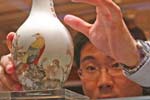Art
Lanzhou gourd sculpting
Updated: 2011-02-15 13:15
(Chinaculture.org)
 |
Gourd sculpting is a well-known traditional craft. Craftsmen use needles to draw people, landscapes, flowers, and other patterns on specially bred gourds, accompanied by poems or calligraphy. The craftsmanship is delicate, exquisite and impressive. With its ethnic characteristics, it is favored by domestic and foreign appreciators.
 |
Origin
Lanzhou gourd sculpting originated out of practicality. Lanzhou city, as the most important spot on the Silk Road, attracted many merchants. Merchants from the Hu tribe held water in giant gourds that were sculpted with Chinese characters and patterns, and Chinese inland merchants transported the gourds to foreign countries. At that time, gourd sculpting techniques were rough. Medicine sellers hung huge gourds with the Chinese character “药(yao)” (medicine) in the doorway of their shops. During the Tang Dynasty, the sculpting technique of gourds developed in a more exquisite way, turning the gourds into art pieces.
Gourd sculpting is a special art, not only because it has a long history in Lanzhou city, but also because people who learn sculpting have abundant artistic training. A master of sculpting should have exquisite sculpting techniques and knowledge of Chinese classical culture, poems, ancient books and records, calligraphy, and drawing. Therefore, the subjects for gourd sculpting are abundant: Tang poems, Songci Poetry, Buddhism, famous classic writings, various plantations, flowers, birds, fish, insects, natural sceneries, etc. The abundant knowledge of the sculptor makes his every piece unique, accurate and exquisite. Today in Lanzhou city, there are many gourd sculptors. Even the gourds found among a vendor’s items is delicate.
Technique
There are two kinds of gourd-sculpting techniques. The first method employs specially made steel needles in different sizes, engraving the patterns in thin lines on the surface of the gourds, and then paints inks on the lines to bring them out. The technique is called “portray.” Another method involves hollowing out the gourds, then drawing the patterns in thick lines. The technique is called “sculpting.” When the patterns are down, “卐” patterns are drawn. For the last step, chemical or silver pedestals are added to the gourds, and the whole production process is finished.
Gourd sculpting can be divided into two categories: gourd-engraving and gourd-carving. Gourd-engraving differs from other gourd sculptures in its production process. It mixes mold-production, engraving, heating, collating, and becomes a comprehensive gourd art. It uses various-sized natural gourds, reorganizing the parts into various gourd sculptures.
If engraving is added to the collage, the gourds become more artistic. The methods used on gourd-engraving are based on the experience of bamboo-sculpting and wood-sculpting. The sculptor is required to be peaceful in mind, accurate and delicate in technique, slight in strength, and slow in pace. This is how exquisite gourd sculptures are produced.
Gourd-carving, namely carving calligraphy and paintings on gourds, produces artistic gourds for people to appreciate. Gourd-engraving is a three-dimensional art, but in gourd-carving, all the work is done on the surface of the gourds.
Gourd-carving is said to have originated in Gansu province. People carved the gourds into simple patterns for appreciation. With continued improvement of craftsmanship, specialized gourd-carving art was formed.
 |
Lanzhou Gourds
The gourds used for sculpting are herbal fruits, solid, smooth, yellowish brown in color, looking like eggs. Therefore they’re called “egg gourds.” Mostly they’re round, but some of them are oval. Lanzhou gourd sculpting started during the Qing Dynasty. Legend has it that there was a tailor named Wang who often sculpted scenic patterns on egg gourds for himself to appreciate. This can be considered the start of Lanzhou’s gourd-sculpting business.
 |
Specials

Share your China stories!
Foreign readers are invited to share your China stories.

Art auctions
China accounted for 33% of global fine art sales.

Waiting for drivers' seat
Lack of sponsorship appears to be why Chinese drivers have yet to race in a Formula 1 event